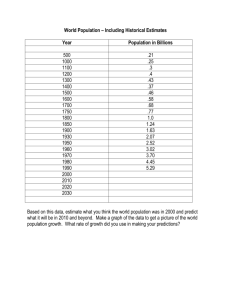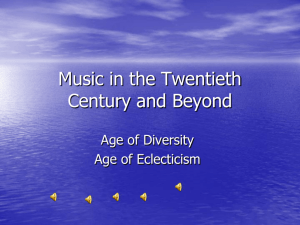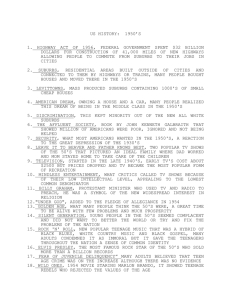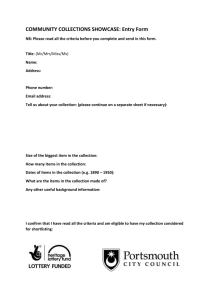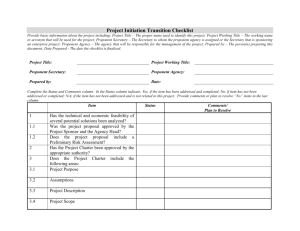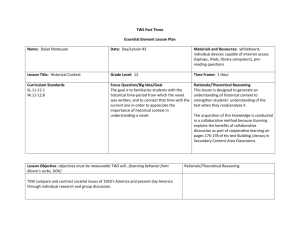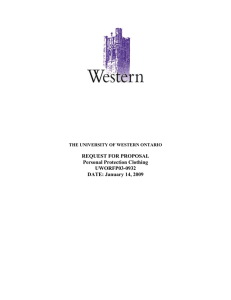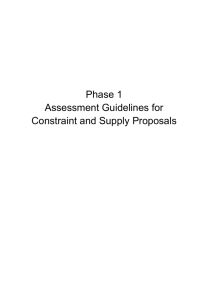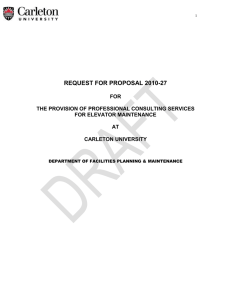I. Cultural Background
advertisement
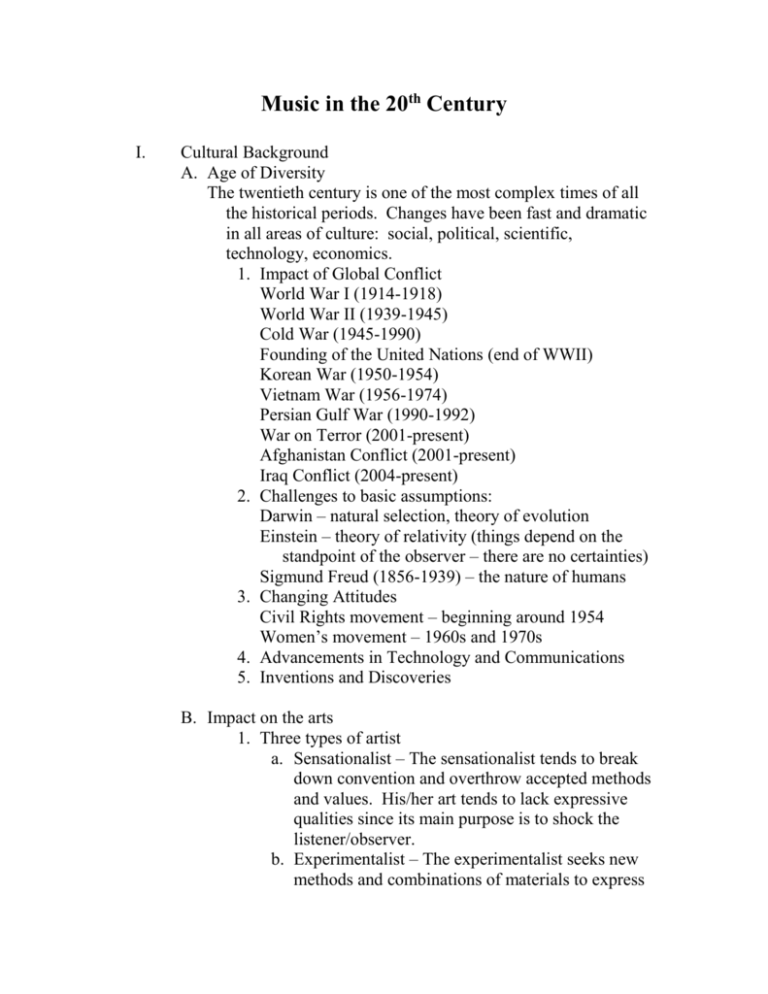
Music in the 20th Century I. Cultural Background A. Age of Diversity The twentieth century is one of the most complex times of all the historical periods. Changes have been fast and dramatic in all areas of culture: social, political, scientific, technology, economics. 1. Impact of Global Conflict World War I (1914-1918) World War II (1939-1945) Cold War (1945-1990) Founding of the United Nations (end of WWII) Korean War (1950-1954) Vietnam War (1956-1974) Persian Gulf War (1990-1992) War on Terror (2001-present) Afghanistan Conflict (2001-present) Iraq Conflict (2004-present) 2. Challenges to basic assumptions: Darwin – natural selection, theory of evolution Einstein – theory of relativity (things depend on the standpoint of the observer – there are no certainties) Sigmund Freud (1856-1939) – the nature of humans 3. Changing Attitudes Civil Rights movement – beginning around 1954 Women’s movement – 1960s and 1970s 4. Advancements in Technology and Communications 5. Inventions and Discoveries B. Impact on the arts 1. Three types of artist a. Sensationalist – The sensationalist tends to break down convention and overthrow accepted methods and values. His/her art tends to lack expressive qualities since its main purpose is to shock the listener/observer. b. Experimentalist – The experimentalist seeks new methods and combinations of materials to express themselves. His/her art often lacks unity and coherence. The price that is paid for experimentalists is that they seldom perfect what they invent. c. Synthesist – The synthesist combines what is good of the sensationalist and the experimentalist with what is valid from the past. His/her art usually is less brilliant; yet is more resilient to the test of time 2. Common principles among 20th-century artists a. break with tradition (rejection of Romantic) b. rejection of subjective emotion as the primary basis for art. c. rejection of concept that art must be realistic or literal d. rejection of unnecessary ornaments and attempts to “dress up” art. The motto is “form follows function” (architecture). e. There is little attempt to please or entertain; only for a desire to reflect the age directly and unashamedly. C. Visual Arts from 1900-1950 1. Impressionism Claude Monet (1840-1926) Impression Sunrise, 1872 Rouen Cathedral, 1894 Edouard Manet (1832-1883) Dejeuner sur l’herbe, 1863 (Luncheon on the Grass) Edgar Degas (1834-1917) The Rehearsal, 1874 Pierre Auguste Renoir (1841-1919) Le Moulin de la Galette, 1897 Post-Impressionists: Georges Seurat (1859-1891) Sunday Afternoon on the Island of La Grande Jatte, 1886 Vincent van Gogh (1853-1890) Starry Night, 1889 2. 3. 4. 5. 6. 7. Paul Gauguin (1848-1903) Day of the Gods, 1894 Modernism Piet Mondrian – Composition with Red, Blue and Yellow Georges Braque – Woman with Guitar Expressionism (1910-1939) Edvard Munch – The Scream Cubism (1908-1914) Pablo Picasso – Three Musicians Marc Chagall – The Green Violinist Dadaism (World War I) Marcel Duchamp – L.H.O.O.Q. Abstract Art (1920’s in Germany, Russia. Netherlands) Piet Mondrian – Broadway Boogie-Woogie Surrealism – grew out of the Dada movement. Salvador Dali – The Persistence of Memory Joan Miró – Ballerina Listening to an Organ Play in a Gothic Cathedral D. Musical style from 1900-1950 1. Musical Centers – France, Germany, United States 2. Elements of Music a. Rhythm b. Melody c. Harmony d. Texture e. Dynamics f. Tone color g. Orchestration h. Form i. Jazz 3. Variety of styles (eclectic) a. Impressionism Claude Debussy (1862-1918) Prélude à l’après-midi d’un faune (1894) Maurice Ravel (1875-1937) Bolero (1928) b. Nationalism Charles Ives (1874-1954) Putnam’s Camp, Redding, Connecticut (1912) Aaron Copland (1900-1990) Appalachian Spring, 1943-1944 c. Neoclassicism Igor Stravinsky (1882-1971) Rite of Spring, 1913 d. Serialism Arnold Schoenberg (1874-1951) “Moondrunk” from Pierrot Lunaire, 1912 e. Expressionism Alban Berg (1885-1935) Wozzeck (1917-1922) f. Avant-garde II. Radical Experimentation and Postmodernism: The Arts since 1950 A. Cultural Influences After WWII in 1945 the world was greatly altered: 1. Politically: establishment of nations, continual struggle for control, 3rd world vs. major powers 2. Economically: international trade, commercialization 3. Socially: mobility of society, human rights, social concerns, drugs, HIV/AIDS 4. Technologically: RB, world communication, internet, electronics, computer, Palm Pilots B. Other Influences 1. Radical Experimentation 2. Postmodernism C. Visual Art 1. Assemblage Robert Rauschenberg – Odalisk 2. Abstract Expressionism Jackson Pollock – Autumn Rhythm, Number 30 3. Pop Art Andy Warhol - Green Coca-Cola Bottles 4. Op Art (Optical Art) Bridget Riley – Current D. Music Since 1950: General Characteristics 1. Increased use of 12-tone system during the 1950’s and 1960’s. Proponent: Aaron Copland 2. Total Serialism: use of the techniques of 12-tone to organize rhythm, dynamics and tone color during the 1940’s and 1950’s. Proponents: Milton Babbitt, Karlheinz Stockhausen, Pierre Boulez 3. Aleatoric Music or Chance music: composer chooses pitches, tone colors and rhythms by random methods, or allows the performer to choose much of the music material. Proponent: John Cage 4. Minimalism: characterized by a steady pulse, clear tonality and insistent repetition of short melodic patterns. Proponents: Terry Riley, Steve Reich, Philip glass, John Adams 5. Music Quotation: works containing deliberate quotations from earlier music. Proponents: Ellen Taaffe Zwilich, George Crumb, George Rochberg 6. Tonal Music and a return to tonality: “New Romantics” Proponents: David Del Tredici, George Rochberg 7. Electronic Sounds: The development of tape studios, synthesizers and computers in the 1950’s and 1960’s resulted in potentially unlimited resources for the production and control of sound. Composers are no longer limited by human performers. Proponent: Milton Babbitt 8. Liberation of sound: greater exploitation of noise-like sounds. Increased use of microtones. Proponent: Krzysztof Penderecki 9. Mixed Media: Music (often electronic) is presented together with visual counterparts (slides, films, gestures, theatrical action) E. Music Since 1950: Representational Pieces 1. Semi-Simple Variations (1956) Milton Babbitt 2. Poème électronique (1958) Edgard Varèse 3. Ancient Voices of Children (1970) George Crumb 4. Einstein on the Beach (1976) Philip Glass 5. Concerto Grosso 1985 Ellen Taaffe Zwilich 6. Short Ride in a Fast Machine (1986) John Adams F. Four important influences on 20th/21st century music 1. Women’s movement (1960’s) 2. Economics of composing 3. Computer/Midi 4. Popular and Classical fusion G. Summary
